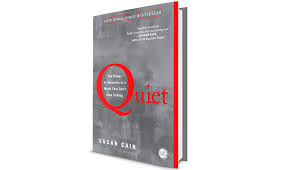Quiet: The Power of Introverts in a World That Can’t Stop Talking
In this fantastic and immensely informative book, Susan Cain introduces readers to the historical, social, psychological, and scientific aspects of the introvert-extrovert dichotomy and offers in-depth explanation about why the distinction is important for everyone to understand. Cain uses a wide breadth of research-based examples to demonstrate that introverts are not a personality subgroup that is less-than or lacking in comparison to extroverts; but rather they are a group of people who have a unique and equally important set of skills and strengths that they offer the world. Introverts should be included, not forced to convert or conform, in decisions about how to design our classrooms, workplaces, and relationships.
Cain argues that beginning at the start of the 20th century, the long-valued character strengths of commitment, reliability, determination, and long-term goal setting began to give way to a “new” model of the ideal American: loud, outgoing, talkative, aggressive, comfortable with strangers or crowds, and quick to make choices. In other words: an extrovert. These skills allowed Americans living during the enormous changes of the Industrial revolution — including the rise of corporations, mass immigration to cities, decrease in work in single pursuits (farming, shop-keeping) in favor of working for large businesses — and workers who exemplified these new ideals were better suited to succeed in 20th century versions of education, business, and social life.
The worship of extroversion, and the demonization of introversion, soon had transformed education, advertising, religion, and psychology and even pediatrics. Quiet, reflective, people (especially children) who took time to make decisions, preferred to single-task, and needed quiet time away from others were seen as lacking and needed to be forced to change. As the century unfolded, American culture began to more and more reward extroverts and demand that introvert learn to “fake” skills of extroversion or accept lesser social and professional success. As of result, more than one hundred years later, the skills associated with extroversion have become the skills that represent “universal success.” It is has become widely accepted that louder, more outgoing, more assertive people are the ideal workers and partners.
Cain’s book seeks to transform that idea. She offers evidence that introverts, with their more subtle skills — long-range planning, aversion to risk, contemplative problem solving, and comfort with delayed gratification — can, if allowed to flourish, transform businesses, classrooms, research labs, and even personal relationships. Offering examples of well-known but successful introverts — Rosa Parks, Bill Gates, Albert Einstein — and presenting fascinating new research from social science, psychiatry, and neurobiology; Cain presents an alternative way of viewing the traits of introversion; she offers examples of ways that introverts are a valuable resource in all areas of life; and she even offers concrete ways that introverts can set up their environment for success…and ways that the world can better accommodate introverts.
You can find Susan Cain’s wildly popular TED talk The Power of Introverts and hear about her research into Introversion.







